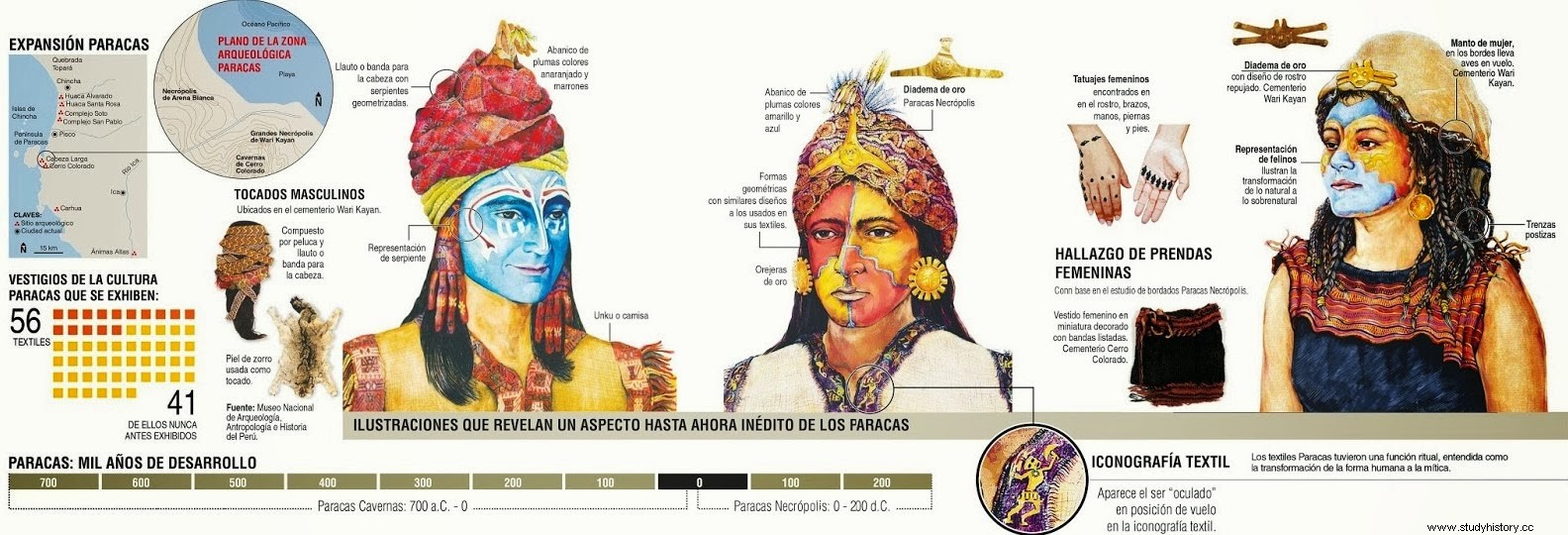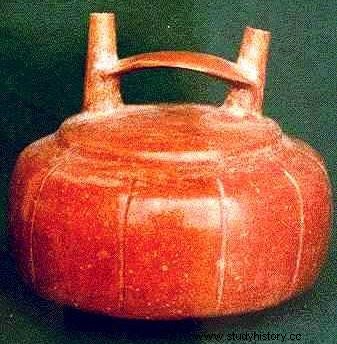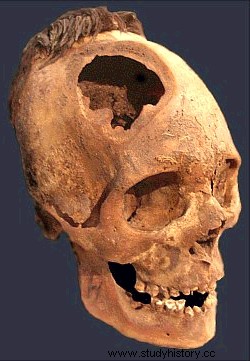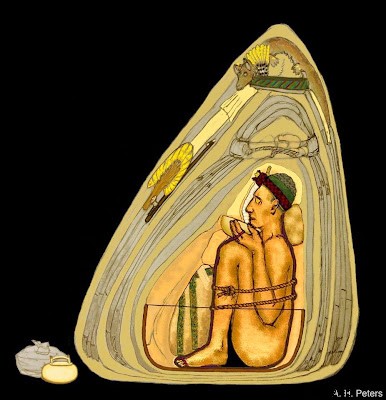Chavín does not disappear completely or suddenly. His elements continued to be active in numerous Peruvian cultures.
1.- Some of them were more conservative, more "Chavines", than others and reflected the Chavín style for a longer time.
2.- Others cultures were released sooner.
3.- There were also cultures that served as a "bridge" between Chavín and regional cultures. These are the cultures of Transition of the final formation. As can be seen in the following table:
 Table proposed by Pablo Macera."History of Peru 1" A Chavín derivation, which later drew its own features, was Paracas. Nestled in the middle of the coastal desert (Ica) this culture was the result of a fusion of local tradition, fishing villages, with the most sophisticated technologies and “chavinoid” ideological forms. It arose at the end of the First Horizon and continued its existence until the first epoch of the Early Intermediate. On the south coast it was the bridge between Chavín and Nazca.
Table proposed by Pablo Macera."History of Peru 1" A Chavín derivation, which later drew its own features, was Paracas. Nestled in the middle of the coastal desert (Ica) this culture was the result of a fusion of local tradition, fishing villages, with the most sophisticated technologies and “chavinoid” ideological forms. It arose at the end of the First Horizon and continued its existence until the first epoch of the Early Intermediate. On the south coast it was the bridge between Chavín and Nazca.THE PARACAS SOCIETY
(700 BC - 200 BC)
LOCATION : This town inhabited the small valleys of Ica and Pisco as well as the Paracas peninsula (Department of Ica); characterized by having deserts that heat up quickly when they receive the sun's rays, which favors the formation of high-speed circular winds that raise sand. That is why this area is called "Paraca", which means:rain of sand. If to all this we add that the rivers are short-distance and have an irregular regime, we deduce that the geographical space of the Paracas culture was transformed to be inhabitable, which is a clear response to the adversities of the environment, which constitutes a example of a resolved contradiction.

BACKGROUND: The Paracas inherited the achievements of the ancient inhabitants of Santo Domingo and received the influence of Chavín in the 700s B.C. But after the decline of the Chavín de Huántar theocracy, the people of Paracas created an art in their own style, which later served as the basis for the Nazca culture. The scholar Julio C. Tello, discoverer of this culture in 1925, has divided the development of the Paracas into two periods, according to the type of burial practiced.
CAVERN PERIOD (700 - 500 BC)
It was the first moment, where a great Chavinian influence is observed, mainly in its religion, specifically on the Ica region. For this reason, the Paracas made ceramics with feline motifs, like those of Chavín.
They built underground tombs in the shape of an inverted cup called caverns; mummies wrapped in funerary bundles were placed there. The tombs had a special symbology, they represented the return to the "womb" of the mother earth goddess (Mamapacha), to be reborn and continue living in the afterlife; that philosophy they developed with respect to man and the world. Its Capital was Tajahuana (Ceremonial Center)

NECROPOLIS PERIOD (500 - 200 BC)
Named for the presence of extensive, semi-underground mass graves; Located on the Paracas peninsula, on the banks of the Pisco and Topará rivers, they were true "cities of the dead" (necropolis). In this period the inhabitants develop their own art and are "freed" from the influence of Chavín, which is expressed some time later in the colorful fabric, based on cotton, wool and hair; and in pottery, which, although monochromatic, does not present designs with the shape of an ororongo. It is the Transition Period from the 1st horizon to the «Early Intermediate» and its capital was Topará.

ECONOMY:
They developed agriculture:they grew beans, cotton, corn and fruits, in the valleys of Pisco, Chincha and Ica. The implementation of techniques to obtain and conserve the scarce water that circulates in these valleys was a fundamental factor in achieving an economic surplus. The economic complement to increase production was fishing and shellfishing, since they knew how to take advantage of one of the richest seas in the world. They also established trade relations with the inhabitants of Huancavelica and Ayacucho, from whom they obtained wool in exchange for salt (barter).
"... The Paracas learned about agriculture, textiles, pottery and fishing. did not reach a greater boom. They developed advanced irrigation technology, as well as weaving, causing a notable increase in production. The priests, likewise, directed the production of goods. The military, using wars and repression, defended private property and the overexploitation of mainly agricultural and artisanal workers.The labor force is made up especially of peasants, fishermen and artisans (weavers, potters)...The social relations of production were totally unequal, because agricultural, artisanal and marine workers had to deliver a considerable part of their production to the priests, civil court and military sector The workers were not owners of any. Everything belonged to the priest lords; those who collectively took possession of the means of production where the labor force was included " (Vargas Salgado – 1987).
SOCIAL AND POLITICAL ORGANIZATION
Like other societies of the Final Formative, Paracas was divided into social classes. Soldiers and priests ran the state, while peasants and artisans formed the working sector. The stratification was formed from the appropriation of the surplus, by the group that controlled knowledge, production and weapons, thus establishing a privileged condition. Peasants, potters and fishermen worked hard to feed the ruling class, paid tribute, built tombs and learned from the priests the cult of felines, birds and other mythological beings.
 Representation of Paracas elite man
Representation of Paracas elite man  Paracas Cultural Society CULTURAL EXPRESSIONS
Paracas Cultural Society CULTURAL EXPRESSIONS Ceramic:
In the Caverns phase, the pottery was polychrome, but painted after firing (painted after firing) and, therefore, easily erased over time. The influence of the Chavín theocracy was reflected in the feline motifs on Chavín pottery. Gourd-shaped, with a bridge handle with 2 peaks. When passing to the Necropolis phase, a great change took place in this art, the motifs were fish and birds framed in a blackish color (monochrome), obtained by precooked painting (which Nazca would later assimilate). This pictorial style is a sign that the Chavín theocracy had lost influence.
 Paracas style mate cave Textiles: “The best textile factory in America”
Paracas style mate cave Textiles: “The best textile factory in America”In the beginning they only used cotton, but later they added wool and hair to make better quality fabrics. On a blue or tobacco background, they embroidered zoomorphic and anthropomorphic figures in bright colors:yellow or orange, reversible figures of great quality at the service of the warrior nobility. The interlacing was complex, with a large number of threads that crisscrossed in an incomparable density. For the peasants, fishermen, artisans, the fabrics of their garments were very simple, coarse and of muted colors, (even in the way they dress, the social differentiation in Paracas is already noticeable). Use of dyes such as achiote and animal such as cochineal. Anthropomorphic and geometric motifs. According to Dr. Victoria de la Jara, geometric figures that she called TOKAPUS can be seen on her cloaks. (possible Paracas writing).

"Threads of Power"
In the Andes, textiles mainly symbolized power because they directly represented the coupling and organization of various levels and society. The investigation shows that the most elaborate textiles belonged to societies with greater control of power. As an example we have the splendid richly embroidered mantles that were used to wrap the mummies of the most important characters whose level deserved long hours of manual work. They symbolized power while they lived and glorification after death. It is believed that the textiles were texts that kept religious knowledge, something that is still "indecipherable to the Western eye." «Textiles Paracas» Pre-Hispanic Cultures Trade
Medicine:
Warriors with tumors, pain and contusions in the head or people apparently of "strange behavior" had their skulls trepanned, an operation performed with an obsidian knife, sperm whale tooth tweezers, cotton and coconut with chicha . The success of this operation is evidenced by the regeneration of bone tissue that occurs at the edge of the hole, made by the Hampi Camayoc (surgeon) in the patient's skull. (Tello, a career doctor, detected these characteristics and even found two trepanations in the same skull). The procedure was meticulous:first the patient was numbed with chicha or coca, then his head was shaved, then demarcation lines were made with transverse parallel lines, the scraping continued with the obsidian stone knife until the skull was uncovered; Finally, with the sperm whale teeth, they extracted the splintered bones, the tumors, and then sealed with gold or matte foil, thus managing to recover the patient, forming the "bone callus".

"Cranial trepanations were the profound knowledge of the Paracas man , where almost 40% of the corpses found in Cerro Colorado present palpable traces of bloody operations carried out on the head Trepanations performed by means of the scraping method and circular incisions are frequent, and the extensive reactions that sometimes compromise almost the half of the cranial cap " (Guibovich – 1989).

RITE OF CRANIAL TREPANATION
 Cranial Trepanation Techniques In the Paracas culture mummification was also practiced by first extracting the brain mass, viscera and some muscles of the dead. Through the use of fire, certain chemical and organic substances, such as lime, ground chili powder, ground salt, powdered muvia flower, pitch and other ingredients that are still unknown. Then came the wrapping of the corpses, the same ones that have followed a preconceived wrapping process after mummification. There were also certain cranial deformities resorting to llautos or ropes tied around the children's heads. These were called "long heads" (Guibovich – 1989).
Cranial Trepanation Techniques In the Paracas culture mummification was also practiced by first extracting the brain mass, viscera and some muscles of the dead. Through the use of fire, certain chemical and organic substances, such as lime, ground chili powder, ground salt, powdered muvia flower, pitch and other ingredients that are still unknown. Then came the wrapping of the corpses, the same ones that have followed a preconceived wrapping process after mummification. There were also certain cranial deformities resorting to llautos or ropes tied around the children's heads. These were called "long heads" (Guibovich – 1989). Forms of cranial deformation "They dissected the corpses, mainly of the nobles; all this "evidences the existence of specialist doctors who were experts in the art of wrapping the corpses and conditioning the different pieces of cloth or mantles that cover the mummies " (Rossel Castro, Alberto – South Peru Archaeologist).
Forms of cranial deformation "They dissected the corpses, mainly of the nobles; all this "evidences the existence of specialist doctors who were experts in the art of wrapping the corpses and conditioning the different pieces of cloth or mantles that cover the mummies " (Rossel Castro, Alberto – South Peru Archaeologist).They mummified the dead and placed them in bundles with abundant objects to be used in the next life; higher-ranking individuals received more textile offerings, up to three successive layers.The burials have a collective character and it is assumed that they responded to criteria of kinship.
 Funeral bundle infographic
Funeral bundle infographic 
